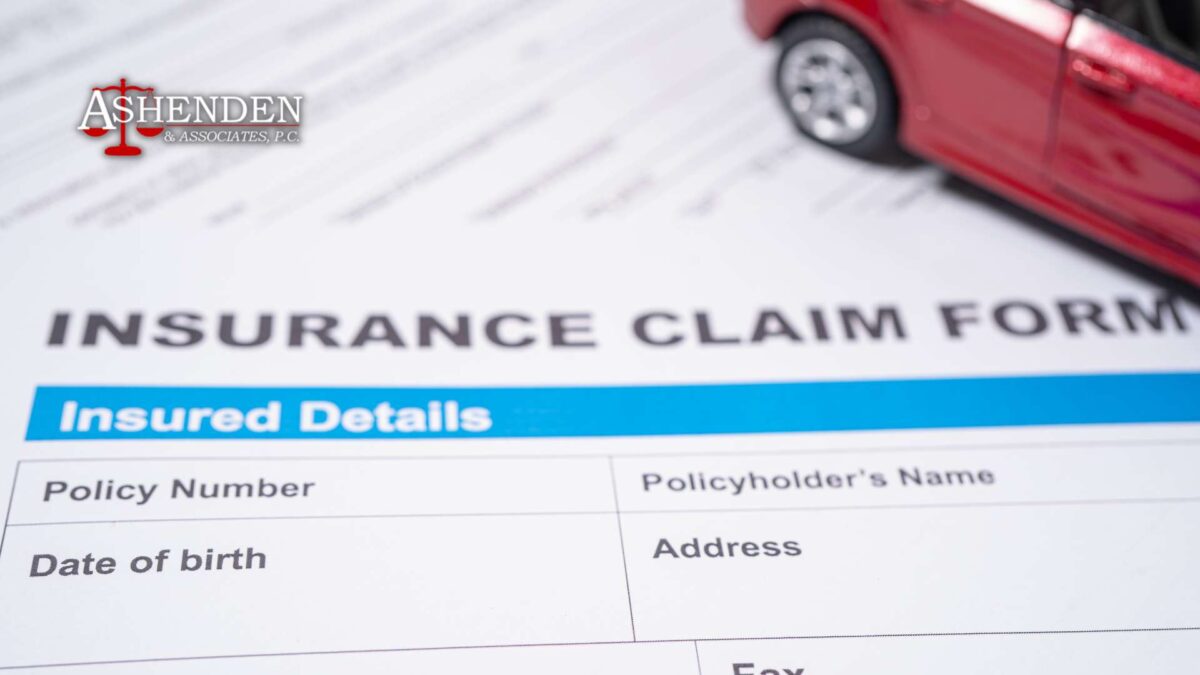What is a diminished value claim? Our Sandy Springs car accident lawyer team explains how to file a diminished value claim, how to calculate diminished value, and how the personal injury claims process can help you receive the accurate value for your car following an auto accident.
If you were involved in a car accident, the Sandy Springs personal injury attorneys from Ashenden & Associates are ready to help. To discuss your case with one of our attorneys, call 770-394-8909 today to schedule a free consultation.
What is Diminished Value?
After an accident occurs, the value of your vehicle will diminish regardless if you have a repaired vehicle already or not. Even if the necessary repairs are made that restore the car to its condition prior to the accident, the market value of your vehicle will still decrease. This difference between the car’s market value before and after the accident is considered the diminished value of your vehicle.
This value will affect its resale value, but you may be eligible to file a claim worth the diminished value of your vehicle to recover the vehicle’s loss in value. The Sandy Springs auto accident attorneys will explain more below.
Types of Diminished Value Claims

Three types of diminished value represent how a vehicle’s value has been reduced. The different types of diminished value claims are immediate diminished value, repair-related diminished value, and inherent diminished value claim types.
Inherent Diminished Value
After an accident, a vehicle will lose value even if the damages are minor. Inherent diminished value is the adjusted value of the car after having accident on its record. Even if the vehicle did not have severe structural damage, the value of the vehicle will be diminished due to the accident, not due to the vehicle damage itself.
Car owners can file an inherent diminished value claim to recover the difference between what an identical vehicle would have sold for if the accident history was clean.
Immediate Diminished Value
The immediate diminished value is less common than the inherent counterpart and is typically used in the courts. This value calculates the vehicle’s resale value immediately after the accident and before any repairs have been made.
Filing an immediate diminished value claim with an insurance company is extremely uncommon since the insurance company already covers repair costs if the driver has the necessary coverage.
Repair-Related Diminished Value
If a vehicle receives low-quality repairs after an accident, the car’s decreased value is referred to as repair-related diminished value. For example, if the auto body shop cannot match the vehicle’s original color and the replaced panels don’t match the original, the vehicle’s repair-related diminished value is decreased even more based on the poor repair job. Had the repairs been of higher quality, they would have had a higher diminished value.
A repair-related diminished value claim can be filed when a car receives low-quality repairs. This is one of the types of diminished value that allows owners to recover the additional losses above the base loss of value that were incurred due to the poor repairs.
How to Calculate Diminished Value

In order to calculate diminished value, car insurance companies commonly apply the 17C Diminished Value Formula. The formula was named following a car insurance claims lawsuit in Georgia, Mabry V. State Farm, where the formula appeared in paragraph 17 in section C.
When filing a diminished value claim, your own insurance company will perform the 17C calculations for calculating diminished value, but we’ve listed the steps below to calculate diminshed value in case you’re interested in calculating diminished value for your vehicle.
Determine the Accurate Value of Your Vehicle
The first step in understanding diminished value is to find out your vehicle’s market value. Websites like Kelley Blue Book and NADA have calculators that calculate diminished value for an identical vehicle or multiple vehicles similar to yours. In order to accurately calculate diminished value of your vehicle, you’ll need to input the vehicle’s make, model, mileage, year, and vehicle damage.
Base Loss of Value
Most insurance companies will apply a 10% cap, also called the base loss of value, to the sales value calculated by Blue Book of NADA. This base loss of value is the most a car insurance company will pay for diminished value claims.
Apply a Damage Multiplier
The damage multiplier is another tool that car insurance companies use when determining the diminished value calculation. After the car’s market value has been determined and the base loss of value has been applied, the car insurance company will multiply that amount by a number ranging from 0.00 to 1.00. This damage multiplier for insurance policies is chosen based on the structural damage that was done to the vehicle.
- 1.00 – Severe structural damage
- 0.75 – Major damage to structure and panels
- 0.50 – Moderate damage to structure and panels
- 0.25 – Minor damage to structure and panels
- 0.00 – No structural damage
Apply a Mileage Multiplier
Even though sites like K.B.B. and NADA use the car’s mileage when calculating its value, insurance companies perform their own mileage calculations using a mileage multiplier. Using the figure calculated in the previous step, insurance companies will multiply that value using mileage multipliers. The mileage multiplier based on the car’s milage is used to determine the final diminished value of a vehicle.
Mileage multiplier example, starting from low mileage to high mileage:
- 1.00 – 0 to 19,999 miles
- 0.80 – 20,000 to 29,999 miles
- 0.60 – 40,000 to 59,999 miles
- 0.40 – 60,000 to 79,999 miles
- 0.20 – 80,000 to 99,999 miles
- 0.00 – 100,000+ miles
When to File Diminished Value Claim in Georgia?
While there is a two-year limitation on filing a diminished value claim, it’s recommended to file as soon as possible following the accident. The sooner you file your diminished value claim, the sooner you can begin recovering losses. Waiting to file your claim can also make proving the damages and accident more difficult.
Most insurance companies, however, will not pay diminished value claims when you’re the driver at fault for the accident. If you were the driver responsible for the accident, diminished value claims will most likely be denied.
Does Every Insurance Company Allow You to Claim Diminished Value?
No, not all car insurance companies will pay a diminished value claim. Usually, drivers can file this claim against the at-fault driver if the damage to the vehicle caused significant financial loss.
In some circumstances, an insurance company will pay diminished value claims on your vehicle. If the accident was with an uninsured driver who is determined to be at fault for the accident, you could file a diminished value claim with your own insurance company. However, you must have uninsured motorist coverage on your insurance policy to file a diminished value claim involving an uninsured driver.
When filing a diminished value claim with your insurance company, it’s important to discuss your options with an experienced car accident attorney in Sandy Springs. Plus, our attorneys can help answer the question, will my insurance company pay for my diminished value claim?
How to File a Diminished Value Claim

If another driver is determined to be at fault for the accident, your chances of being able to file a diminished value claim successfully increase.
To file a diminished value claim, drivers should follow the steps below:
- Research the insurance company’s process and steps to file a diminished value claim.
- Calculate diminished value and document the vehicle’s market value with Kelley Blue Book or NADA.
- Prove your vehicle’s loss using photos and documentation from the accident. An appraisal from a certified vehicle appraiser can also help diminished value claims.
- Meet the conditions laid out in the insurance policy and file the diminished value claim.
Filing a diminished value claim may seem easy, but the process to file a diminished value claim is much more complicated than filing a typical claim with a car insurance company. Working with an experienced Sandy Springs accident attorney can ease the process of needing to file a diminished value claim and ensure you’ve followed all the required steps to file a diminished value claim successfully.
What to Consider When Filing Diminished Value Claims
Filing a claim may not always be an option for those involved in car accidents. It’s important to remember the following considerations before filing a diminished value claim.
- The vehicle’s value prior to the accident: If your car is older with high mileage or structural damage, you may not receive money from a claim.
- If you were at fault: If you caused the car accident, your insurance company will most likely deny a this type of claim.
- The accident was with an uninsured driver: If you have an uninsured motorist policy, you have a better chance of receiving a payout from this type of claim.
How Long Does a Diminished Value Claim Take?
When you claim diminished value, the process takes longer to recover compensation compared to the standard auto claim. Since these cases are complex, finalizing the claim can take weeks to months.
It’s recommended to hire a Sandy Springs car accident attorney, as they can work with the insurance company on your behalf and ensure that you receive the best results from your claim.
Is Georgia an At-Fault State?
Is Georgia an at-fault state? Yes, Georgia is an at-fault state, meaning the injured party from a car accident can recover damages through the at-fault driver’s insurance company. In addition to being an at-fault state, Georgia also abides by the 50% modified comparative fault rule. According to this rule, a person’s compensation can be reduced based on the percentage they’re found at fault for the accident.
For example, if a person is determined to be 20% at fault in a car accident, the compensation they can recover will be reduced by 20%. If the driver is more than 50% at fault for an accident, they cannot recover any compensation.
When to Hire a Car Accident Lawyer for a Diminished Value Claim

Since diminished value claims are more complicated than the average auto insurance claim, an experienced attorney can help you navigate the process. The Sandy Springs auto accident attorneys from Ashenden & Associates can help you file your claim and ensure you have met all the necessary requirements prior to filing. Most value insurance companies are notoriously difficult to work with, so having an attorney negotiate with them on your behalf can also ease the process while ensuring a successful claim.
Car Accident Damages
In addition to recovering compensation, you may be entitled to other damages following your car accident. If the driver acted negligently and you sustained injuries from the accident, you may be able to recover the following compensation:
- Medical expenses
- Lost wages
- Physical therapy costs
- Pain and suffering
- Emotional distress
- And more
Call Sandy Springs Car Accident Lawyers at Ashenden & Associates Today
If you were involved in a car accident caused by another driver, let the Sandy Springs car accident attorneys from Ashenden & Associates help you file your diminished value claim. To schedule a free initial consultation with one of our attorneys, call 770-394-8909 today.

